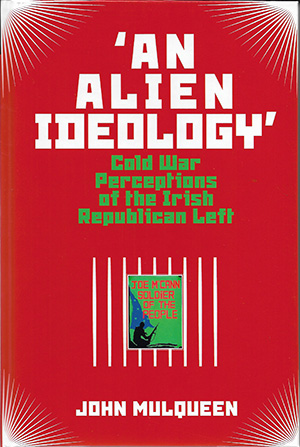‘AN ALIEN IDEOLOGY’: Cold War perceptions of the Irish republican left
Published in Book Reviews, Book Reviews, Issue 2 (March/April 2020), Reviews, Volume 28JOHN MULQUEEN
Liverpool University Press
£75
ISBN 9781789620641
Reviewed by Ruan O’Donnell
 Ruan O’Donnell is Senior Lecturer in History at the University of Limerick.
Ruan O’Donnell is Senior Lecturer in History at the University of Limerick.
Given their centrality to matters pertaining to the recent ‘Long War’ and the burgeoning bibliography of that expansive topic, it is surprising how little has been published on the role of the ‘Official’ IRA and ‘Official Sinn Féin’, as well as later iterations of the same groupings such as ‘Sinn Féin the Workers’ Party’. Seán Swan’s underrated Official Irish Republicanism made a robust foray regarding the early phase of the movement up to 1972 as late as 2007, while the collaboration of Brian Hanley and Scott Millar yielded the widely circulated The lost revolution: the story of the Official IRA and the Workers’ Party in 2009. Except where necessary for contextualisation, John Mulqueen’s ‘An alien ideology’ has not recrossed this contentious and only partially tilled field. Having resisted this impulse, the author instead broadened his focus to situate the long-term evolution of the ideological gestation of the Officials within global strategic affairs. In this respect he has produced a highly original and much-needed text.
The first section of the book addresses the central theme of ‘communists’, with particular reference to the motives of such key figures as Cathal Goulding, Seán Garland, Seamus Costello, Tomás Mac Giolla and others who steered the traditional IRA of their youth in the 1950s towards root-and-branch reforms that yielded the calamitous schisms of 1969, 1972 and 1974. Division proved the price of well-intentioned progression. The marked change in political emphasis during this relatively short period was unprecedented and owed much to international, national, regional and sub-regional factors, as well as to personalities, factions and chance. Few, if any, who ‘dumped arms’ in February 1962 envisaged the razing of Belfast’s Bombay Street in August 1969 and the backlash from the IRA’s weak military response. Organisational stresses had by 1974 produced the Provisional IRA, the Irish Republican Socialist Party/Irish National Liberation Army and an increasingly centralised and doctrinaire ‘Official’ cadre wedded to the consequences of its sudden and mishandled 1972 ‘ceasefire’.
The paucity of reliable information on the early years of the IRSP/INLA has complicated Mulqueen’s task of taking full account of such matters, but that is not his primary responsibility. The violent deaths of Billy McMillen, Joe McCann and Seamus Costello warrant analysis beyond the scope of this volume and will no doubt resurface as major strands of history in due course. A firm identification of the Connolly Association with the programme of the Communist Party of Great Britain and Moscow must await a major study of the oldest Irish-orientated political campaigning body in the UK. Understandably, the interaction of former Connolly Association members Roy Johnston and, to an extent, Anthony Coughlan with Goulding et al. required and has received Mulqueen’s attention. The oft-cited bugbear of the ‘sectarianism of the Left’ in the UK has clouded this clearly important discussion and that of many other pertinent questions.
The migration of formerly militant Official IRA Volunteers into the new INLA from late 1974 echoed the 1914 Redmondite split in the Irish Volunteers (Oglaigh na hÉireann) in that the reduced inner circle gained a freer hand to develop its not-so-hidden agenda of much deeper commitment to international revolution. Despite legally prudent denials, the Official IRA (a.k.a. ‘Group B’) moved forward and partially replenished its ranks and armament under the same Goulding/Garland leadership cluster that courted Moscow while calumniating Sinn Féin and the IRSP in Belfast, Derry and Dublin. Mulqueen has acknowledged and referenced aspects of this phenomenon and noted that the ‘annual’ Easter Statement provided by the OIRA Army Council to its adherents in Long Kesh in 1975 had to be delivered verbatim in 1976, as no fresh document had been furnished to the O/C in the interim. The Official leadership was in the process of distancing itself from, but not yet jettisoning, its acknowledgeable armed wing. This facilitated rebranding the movement as Sinn Féin the Workers’ Party, a path that led many via tumult and faction into Democratic Left and the Labour Party.
The main strength of this impressive study of the Officials, however, lies in Mulqueen’s assiduous charting and sophisticated assessment of the spectrum of their links to major international actors, not least the Soviet Union prior to 1991, as well as Albania and North Korea. Irish, British and American archives feature advantageously in the later chapters, which address such under-explored matters as ‘The KGB and Ireland’. State archives are drawn upon with effect to outline many hitherto unknown or obscure aspects of Ireland’s anomalous Cold War experience. Good use is made throughout of ephemeral contemporary papers and pamphlets, which bolster a narrative informed by numerous interviews and the memoirs of Mick Ryan and others. In the absence of a statute of limitations or de jure amnesty for political offences, much vital information on this major subject will remain unsaid or anonymous. In the meantime, Worker’s Life, Teoiric: Theoretical Journal of the Republican Movement and United Irishman can be mined, as Mulqueen has done with forensic precision, for information illuminating the public dimension of the ‘Official’ perspective. An essential volume for any ‘Long War’ collection.
















